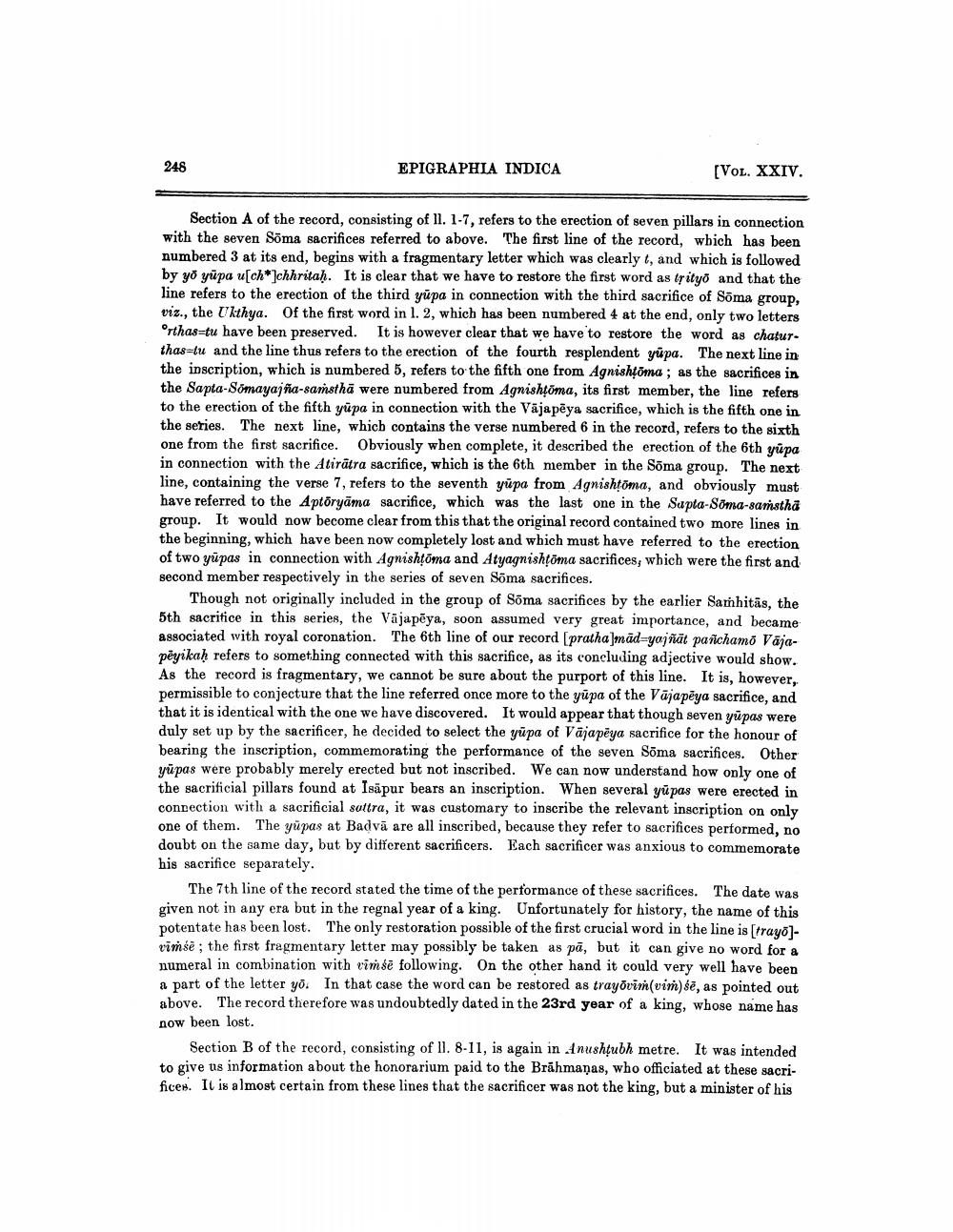________________
248
EPIGRAPHIA INDICA
[VOL. XXIV.
Section A of the record, consisting of ll. 1-7, refers to the erection of seven pillars in connection with the seven Soma sacrifices referred to above. The first line of the record, which has been numbered 3 at its end, begins with a fragmentary letter which was clearly t, and which is followed by yo yupa u[ch]chhritaḥ. It is clear that we have to restore the first word as trityo and that the line refers to the erection of the third yupa in connection with the third sacrifice of Sōma group, viz., the Ukthya. Of the first word in 1. 2, which has been numbered 4 at the end, only two letters °rthas-tu have been preserved. It is however clear that we have to restore the word as chaturthas-tu and the line thus refers to the erection of the fourth resplendent yupa. The next line in the inscription, which is numbered 5, refers to the fifth one from Agnishtoma; as the sacrifices in the Sapta-Somayajña-samstha were numbered from Agnishtoma, its first member, the line refers to the erection of the fifth yupa in connection with the Vajapeya sacrifice, which is the fifth one in the series. The next line, which contains the verse numbered 6 in the record, refers to the sixth one from the first sacrifice. Obviously when complete, it described the erection of the 6th yūpa in connection with the Atiratra sacrifice, which is the 6th member in the Soma group. The next line, containing the verse 7, refers to the seventh yupa from Agnishtōma, and obviously must have referred to the Aptöryäma sacrifice, which was the last one in the Sapta-Soma-samsthā group. It would now become clear from this that the original record contained two more lines in the beginning, which have been now completely lost and which must have referred to the erection of two yupas in connection with Agnishtoma and Atyagnishṭoma sacrifices, which were the first and second member respectively in the series of seven Sōma sacrifices.
Though not originally included in the group of Soma sacrifices by the earlier Samhitas, the 5th sacrifice in this series, the Vajapeya, soon assumed very great importance, and became associated with royal coronation. The 6th line of our record [pratha]mad-yajñāt pañchamo Vājapeyikaḥ refers to something connected with this sacrifice, as its concluding adjective would show. As the record is fragmentary, we cannot be sure about the purport of this line. It is, however, permissible to conjecture that the line referred once more to the yupa of the Vajapēya sacrifice, and that it is identical with the one we have discovered. It would appear that though seven yūpas were duly set up by the sacrificer, he decided to select the yupa of Vajapeya sacrifice for the honour of bearing the inscription, commemorating the performance of the seven Sōma sacrifices. Other yupas were probably merely erected but not inscribed. We can now understand how only one of the sacrificial pillars found at Isäpur bears an inscription. When several yupas were erected in connection with a sacrificial sottra, it was customary to inscribe the relevant inscription on only one of them. The yupas at Badva are all inscribed, because they refer to sacrifices performed, no doubt on the same day, but by different sacrificers. Each sacrificer was anxious to commemorate his sacrifice separately.
The 7th line of the record stated the time of the performance of these sacrifices. The date was given not in any era but in the regnal year of a king. Unfortunately for history, the name of this potentate has been lost. The only restoration possible of the first crucial word in the line is [trayo]vimse; the first fragmentary letter may possibly be taken as pā, but it can give no word for a numeral in combination with vimse following. On the other hand it could very well have been a part of the letter yo. In that case the word can be restored as trayōvim(vim) se, as pointed out above. The record therefore was undoubtedly dated in the 23rd year of a king, whose name has now been lost.
Section B of the record, consisting of 11. 8-11, is again in Anushṭubh metre. It was intended to give us information about the honorarium paid to the Brahmaņas, who officiated at these sacrifices. It is almost certain from these lines that the sacrificer was not the king, but a minister of his




